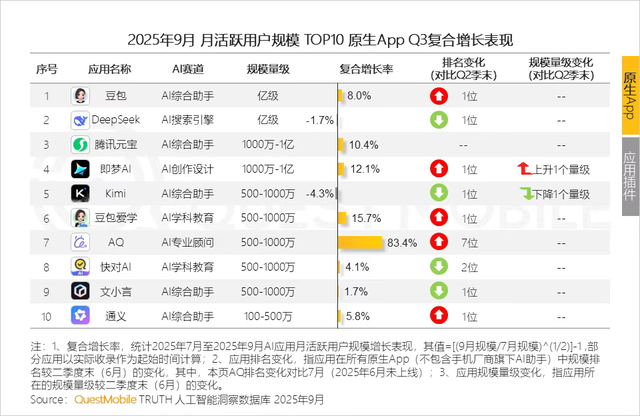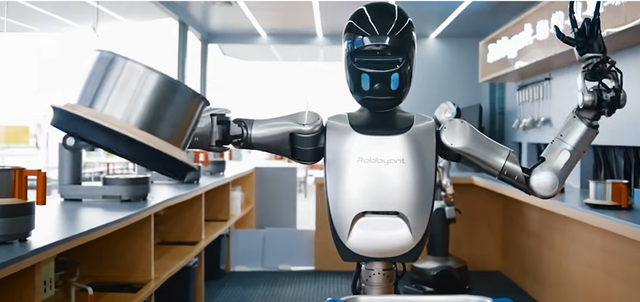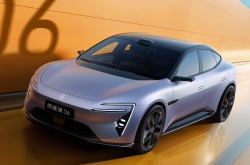Ant's AI Strategy: Far More Than a Fleeting Spark of Brilliance
![]() 11/28 2025
11/28 2025
![]() 427
427

Compared to the sudden emergence of Alibaba's Qianwen, the explosive popularity of Ant Group's (hereinafter referred to as 'Ant') general-purpose AI application, 'Lingguang,' came as somewhat of a surprise.
Last week, Ant's Lingguang App quietly claimed the top spot on the charts of major app stores. In just six days post-launch, downloads surpassed the 2 million mark. According to the founding team, 'This achievement has eclipsed our year-end KPI well ahead of schedule.'
With ChatGPT amassing over 800 million users, Doubao exceeding 172 million active users, and Qianwen attracting 10 million users within a week of its debut, it's clear that every major tech company is vying for a leading AI application aimed at consumers (C-end).
However, the release of 'Lingguang' might seem like a bid for C-end market share, but this seemingly spontaneous product is more akin to a 'spillover' achievement from Ant's three-year strategic positioning in the AI sector.
Prior to Lingguang, Ant's AI applications were predominantly focused on vertical industries such as finance and healthcare.
In 2024, Ant CEO Han Xinyi elaborated on the specific layout of the AI First strategy, highlighting three major AI application services—finance, health, and lifestyle—as Ant's most promising directions in the AI era.
Since 2023, Ant has been developing AI assistants in three key areas: AI Health Assistant AQ, AI Financial Assistant Ma Xiaocai, and AI Lifestyle Assistant Zhi Xiaobao.
'The true value of AI lies in its applications,' Han Xinyi reiterated at this year's World Internet Conference.
So, how will Ant carve out its niche in the fiercely competitive AI application landscape?
Finance, Healthcare, and Lifestyle: Ant's AI Application Focus on Vertical Sectors
Ant's foray into AI applications can be traced back to 2023, coinciding with the explosion of ChatGPT.
In the same year, then-CEO of Ant, Jing Xiandong, laid out three major strategies for Ant Group: 'AI First' (Artificial Intelligence Priority), 'Alipay Dual Flywheels,' and 'Accelerated Globalization.'
Focusing on tangible progress, in the model layer, Ant has been consistently updating its Bailing series of large models since 2023, serving as the technological backbone for the group's transition to AI. In the application layer, Ant leverages its inherent strengths, launching AI assistants in finance, health, and lifestyle to capitalize on vertical sector opportunities.
This strategic choice isn't a blind bet on a trend but a decision rooted in Ant's DNA and an assessment of AI opportunities across various industries.
For Ant, finance and healthcare, as data-intensive industries, are inherently more conducive to AI applications, while lifestyle, being universally applicable, requires AI empowerment.
Taking healthcare as an example, Han Xinyi shared his insights on the AI healthcare sector at this year's conference:
'The unique nature of healthcare underscores the irreplaceability of professional AI. The ultimate goal of AI healthcare is to provide personalized, precise, and credible advice akin to that of a professional doctor, including understanding users' physical conditions, recommending medications reasonably, and offering continuous health management. For the foreseeable future, general-purpose large models will find it challenging to replace vertical professional large models.'
Observing recent developments, whether it's finance, a longstanding strength, or the health business, which has seen its strategic importance elevated this year, Ant has accumulated substantial experience in both areas.
The AI financial assistant was the earliest and fastest to emerge in the financial sector.
Launched in September 2023, the AI financial assistant 'Ma Xiaocai' has undergone several upgrades over three years. Initially powered by Ant's earliest Bailing Large Model and the Finix Large Model tailored for the financial sector, its functions span market analysis, portfolio recommendations, and updated financial report interpretations. According to Ant's official data, as of last August, the product boasted over 70 million monthly active users (MAUs).
In the medical field, which has gradually become a strategic priority, Ant has tackled a formidable challenge through in-depth cultivation.
This month, Ant's CEO announced in an open letter the completion of the largest business architecture adjustment in five years, elevating the 'Digital Medical and Health Business Unit' to the 'Health Business Group,' making medical and health services a strategic pillar of Ant.
Integrating medical and technological services is a proposition that requires collective efforts from multiple stakeholders. For instance, establishing collaborations with top-tier hospitals, enhancing doctors' work efficiency, assisting patients in accessing services, and breaking through industry barriers necessitate both technological strategic positioning and ecological connectivity.
Reflecting on Ant's decade-long development in the medical field, two key collaborations stand out. The first was the implementation of hospital registration and payment systems in 2014, a rigid demand for Chinese users. The second was the promotion of electronic medical insurance codes, driving the coverage of online services. Data shows that the medical insurance code project now reaches 800 million users globally.
With such a wealth of medical resources, Ant has also identified opportunities for application development in the health sector.
In June this year, the independent App of the AI Health Assistant, 'AQ,' was officially launched. Powered by Ant's internal Ant Medical Large Model, this App focuses on health consultations, report interpretations, and health management, featuring an intelligent agent gameplay with AI celebrity avatars. Official data indicates that AQ has served over 140 million users cumulatively.

In the lifestyle sector, it represents a continuation of the ecological advantages built on Alipay.
Last September, Ant unveiled its AI lifestyle assistant, 'Zhi Xiaobao,' at the Bund Summit. It integrates a series of lifestyle scenarios accumulated within Alipay, with the highlight being 'one-sentence activation.' For example, with just one sentence, AI can assist in booking tickets or recharging your phone bill.
Following the strategy of 'Three Major AI Applications,' Ant has achieved certain results by leveraging its accumulated technological and resource advantages.
More notably, by providing uniquely connected services, Ant has penetrated deeper into markets that are traditionally hard to reach. For instance, over 45% of Ma Xiaocai's users hail from third-tier cities, while AQ has over 60% of its users from third-tier markets.
A question arises: Why does Ant, with its strengths in certain industries, choose to develop AI assistant products without prior accumulation? It can be said that Ant's Lingguang App is a phased achievement born out of this year's intensified AI strategy.
From Ant's internal perspective, they believe that the market opportunities are vast enough to accommodate multiple 'Lingguang' apps sharing the pie.
'Whether from a technological or market standpoint, the space for AGI should be enormous,' said He Zhengyu. 'To draw an analogy, if I'm searching for water in the desert, I won't send everyone in one direction. Instead, I'll dispatch multiple teams to search simultaneously. Whoever finds it, we'll all benefit.'
In his view, with DeepSeek offering thinking capabilities and Doubao providing voice calls, each AI assistant product has its unique highlights. After identifying their positioning, there is potential to create a new product.
Establishing an AGI Department and Developing Trillion-Parameter Large Models: Ant Accelerates Its AI Transformation
The explosion of applications must be underpinned by robust foundational model capabilities.
Over the past nearly three years since 2023, Ant's foundational large models have evolved from nascent stages to maturity.
Using the development history of Ant's self-developed Bailing series of large models as a reference, it's evident that their large model technology roadmap is shifting from early designs tailored to vertical businesses to the current pursuit of performance and cost-effectiveness in AGI.
On the roadmap of self-developed large models, Ant started relatively late, officially initiating large model research and development at the end of 2022. However, Ant appears to have ample resources. At the 2023 Bund Summit, He Zhengyu introduced that Ant's foundational large model platform is equipped with a heterogeneous cluster of ten thousand cards.
For a considerable period, Ant's vertical large models have been progressing faster than its self-developed Bailing Large Model.
In September 2023, Ant Group unveiled its financial large model and a dedicated task evaluation set for the financial sector, as well as a code model, CodeFuse, at the Bund Summit. Two months later, Ant's Bailing Large Model announced its approval and commenced internal testing simultaneously. However, compared to the follow-up speed of other major companies, Ant was clearly half a step behind.
But with 2025 as a dividing line, the Bailing Large Model team has finally hit the accelerator, with a direct aim at AGI.
In He Zhengyu's words, 'In model training, you can see that we don't consume as many resources, but we've trained a trillion-parameter model. While others train models that scale exponentially—100B, 200B, 400B, 800B—we directly jump tenfold, from 16B to 100B and then to 1T. This reflects our pursuit of efficiency.'
Since March this year, the Bailing Large Model has undergone a series of updates and open-sourcing, covering large language models (Ling), multimodal models (Ming), and thinking models (Ring).

As the foundational technology supporting the explosion of applications, the Bailing Large Model team is building towards a full-scale, full-modal goal and has completed a comprehensive model family in just eight months:
The Ring (thinking) series is responsible for complex reasoning, planning, and tool usage; the Ling (general) series focuses on non-thinking large language models, pursuing speed and efficiency while maintaining intelligence; the Ming (multimodal) series handles image/video/voice understanding and generation.
Among them, the most critical are the Ling-1T and thinking model Ring-1T updated in October this year. In the tier of trillion-parameter models, few players have chosen open-sourcing. Ring-1T is also the world's first open-source trillion-parameter thinking model.
Behind the non-thinking model Ling-1T, Ant utilized 10T Token of training material. Official data shows that its capabilities in mathematics, coding, and other aspects surpass those of many open-source models at the time.
Ling-1T also extends Ant's pursuit of efficiency. According to official sources, taking AIME 2025 as an example, Ling-1T's accuracy rate exceeds that of Gemini 2.5 Pro, while reducing the token count for single inference by 60%.
Just as seeds need soil to grow, this year, the full-modal Bailing Large Model family can support the emergence of 'Lingguang.'
The Bailing Large Model has also become the foundational model capability underpinning the Lingguang App, making 'Lingguang' a phased achievement in Ant's pursuit of AGI this year.
When discussing the model behind Lingguang, official sources revealed that the main dialogue is supported by the Bailing Large Model but also incorporates multiple mainstream open-source models, including Qianwen.
The positioning of the 'Lingguang' App is primarily as an efficiency app, advocating for helping users quickly screen and obtain key information. Whether it's the visually pleasing answer layout or the simplified user code adjustment design of 'Flash Applications,' the goal is to minimize user barriers as much as possible.
The 2 million downloads in six days clearly exceeded Ant's internal expectations, providing a strong start for 'Lingguang.'
Diving In + Investing: Ant Positions Itself for the Future of Embodied AI
This year, Ant's intensified efforts in AI have become significantly more pronounced.
In March 2025, Ant CEO Han Xinyi assumed office as scheduled, and it was also in this month that the internal AGI team was established.
This year, Ant's exploration of the embodied AI sector has also begun to take shape, adopting a dual approach of self-development and investment to ensure it doesn't miss out on the potential of AI in the physical world.
'The real world and the digital AI world will coexist simultaneously, and we hope to solve AI problems in the real world. That's why we're exploring embodied AI, intelligent driving, and more,' said Han Xinyi at a technology open day this year.
Ant has already taken the plunge. In December last year, Ant Lingbo Technology was established. As a subsidiary of Ant, its business scope includes the research and development and sales of intelligent robots.
The positioning of R1 is very 'Ant'—it directly targets the most vibrant catering scene. In September this year, the first humanoid robot, Robbyant-R1, was unveiled, capable of assisting in cooking and automating the entire process from ingredient preparation to cooking and cleaning.

In terms of investment, Ant has basically covered a large number of leading embodied AI companies, with investments in various aspects of embodied AI, including the body and hands.
So far this year, Ant has invested in five embodied AI companies, including Unitree and Stellar Sea Map for humanoid robots, Titan Tiger Robot, Stardust Intelligence, and Lingxin Qiaoshou for robot dexterous hands.
From top to bottom, Ant is laying a solid foundation with its models while seizing opportunities in the AI application sector. Through short-term goals and multiple attempts, it seeks to find new opportunities beyond the three major AI assistants.






